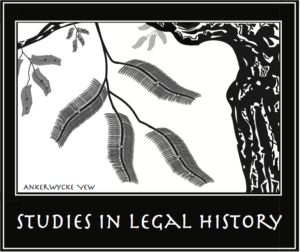Guidelines for Prospective Authors
From the Editors of Studies in Legal History (Holly Brewer, Sally Gordon, Michael Lobban, & Reuel Schiller)
Our Standards and Policies as Editors

Studies in Legal History (SLH) is well known for its editors’ deep engagement in their work. We are active and constructive partners with both experienced authors and first-time authors transforming their dissertation into a monograph. Because we work in conjunction with ASLH, rather than for a press, we are dedicated to the field as a whole, and stand ready to help even those whose work may not appear in SLH. Our editors give timely, detailed, supportive, and deeply scholarly feedback. We also work with authors to make their project both accessible and historiographically important.
Though we are delighted to look at manuscripts at any stage of development, the process works best when authors approach us in the early stages of their project. We are happy to help with development of a book proposal, preparation of revised chapters that illustrate the work, and to strategize about a book’s length, its audience, and the timing of its publication. Once both author and editor are agreed that the project should move to the next stage, we will work with our in-house editor at Cambridge University Press, Debbie Gershenowitz, to send out the work to anonymous outside readers.
Readers’ reports are an essential part of the progress toward a scholarly monograph. Because this stage involves significant investment of time and effort by those readers, we ask authors to commit to working exclusively with SLH once the Press agrees to send the proposal to outside readers. We generally solicit two readers, to give an author a sense of the range of reactions by experts in their area. These reports are often very useful to authors, prompting them to rethink one or another aspect of the project, and usually to gain confidence in the value of their scholarship.
It is on the basis of these readers’ reports that the Press makes its decision on whether or not to offer a contract. Given their importance, we prefer not to send out material to readers until we are fairly confident that the work will be well received by them. If authors wish to have work sent out more quickly, we would like to be told as soon as possible.
Once the reports have been received, the author is asked to respond (usually by letter) to them. If they are favorable, the SLH editor then writes a recommendation memo and puts together a portfolio for the manuscript. This consists of the recommendation memo, the proposal, sample chapters, the author’s cv, the underlying dissertation if any, the readers’ reports, and the author’s response. This package is submitted to the New York editorial board, and then, when approved, is forwarded to the Cambridge syndics, who issue the contract.
Once under contract, the author is obligated to revise along the lines of the response letter, and to work with the SLH editor closely in that process. When the author sends in a final manuscript, the SLH editor will be asked to affirm that the author has satisfied his/her plan for revision and that the editors are satisfied that the book should be published in the series. All permissions for use of images, or any previously published articles, must be in hand at the time the final manuscript is submitted. After the manuscript is accepted by the editor, it will be sent to the press, and will enter the production process, including copyediting, the review of page proofs, cover design, and the creation of an index. We work closely with authors to ensure that the appearance (including the cover) of the published book is of the highest standard. The production process generally takes about nine to eleven months.
We care very much about marketing, reviews, prizes, and other recognitions that follow publication. We work closely with authors to ensure that we promote their work assiduously.
Suggestions for Book Proposals from the editors
This document is designed to make your own work on a book proposal smoother and more successful, and also to give authors a sense of how editors and presses think about projects as they are submitted for their consideration. Every proposal is different, and yours will most likely not follow exactly the template we describe here. Instead, this is a guide rather than a strict formula. Studies in Legal History has a well earned reputation for working closely and collaboratively with authors, and the editors will of course be of whatever assistance they can as you draft your proposal, as well as at later stages as you write a cogent and persuasive book. Our shared commitment to you and to the ASLH is to building the field of legal history. Publication of the best new work in the field is critically important to this endeavor.
A carefully crafted book proposal to the series editors and the Cambridge University Press (which publishes the series) provides an explanation of the scope and weight of your project. The proposal is not simply a list of what your book is about, nor simply a listing of what scholars might like about your book. To craft a strong proposal, you must consider the issues that any press cares about as well, especially issues of sales and markets. Your proposal should contain several components, therefore, and each should address a variety of questions.
- Opening Statement: Following your proposed title and anything following the colon, you need to explain what is exciting and innovative about your project. What main questions and controversies are you engaging in your work? Why is this topic important, both in terms of subject matter and historiography, and how will your work change the way we think about your topic? If you can convey your own excitement, you have a better chance of catching an editor’s attention and convincing readers that your book will sustain their interest. But you need to do so in an informed way, showing you know the historiography in which you are intervening and making a coherent claim for how and why your work will be persuasive. This section should consist of about two or three pages.
- Outline of Content and Argument: The second section of your proposal should explain the shape of the proposed book in much more detail. This section provides the reader with a sense of how the book will flow, and what kinds of materials will be marshaled to sustain the argument(s). Take the reader through the chronology and central events of the book, summarizing the major points in narrative form. This section also provides an opportunity to explore the historiography in more detail in ways that correspond to where prior work will be addressed in your book. In connection with this more detailed explanation of the work, therefore, you are given the opportunity to demonstrate more completely why your approach is fresh, original, and important. You will also need to include an annotated outline of the chapters, either at the conclusion of this section, or at the very end of the prospectus. This section generally runs about five to seven pages (if included in this section, the annotated outline is generally a page or two, three at most).
- A note on length, timing and market: This part of your proposal should address issues such as word count, which is the preferred method among publishers for predicting length. You should aim for a book that is short enough to be used in a college classroom but long enough to make a significant contribution to the literature. We recommend about 110,000-130,000 words including text and notes (which translates into 250-300 printed pages total, including notes). Authors will choose whether to place notes at the bottom of the printed page, or at the end. In addition, authors may include a bibliography or bibliographic essay. You should also consider carefully when you will be ready to submit a complete manuscript to the press. It is generally advisable not to be too optimistic, but instead to assess realistically how much time you will need. It is acceptable to say something like “the anticipated date of submission is spring 2021.” Editors and presses are on the whole ready to grant extensions, especially when they are notified in advance that one or another roadblock has arisen. Equally important, throughout the writing period, the editors will be in touch with you, and are happy to respond to drafts. Finally, you should discuss here who your potential audience might be. What literatures are you engaging–e.g. in addition to legal historians, what groups of law professors and/or historians might be interested? Would your book appeal to other disciplines, such as political science or sociology? Does it address questions of race or gender that could draw in scholars in fields where those issues are especially salient? How would you envision other scholars using the book? Would it be suitable for inclusion, say, in an advanced undergraduate class, or in a law school seminar?
With your prospectus, you will also need to include your c.v. and generally two sample chapters that demonstrate the ways that your proposal will translate into the longer work. The total length of your prospectus should be about 15 – 25 pages (often, proposals longer than 25 pages provide excessive detail that does not enrich the proposal). After reviewing these materials, we will give you feedback on whether your book seems to be a good fit for the series.
Holly Brewer
Sally Gordon
Michael Lobban
Reuel Schiller
